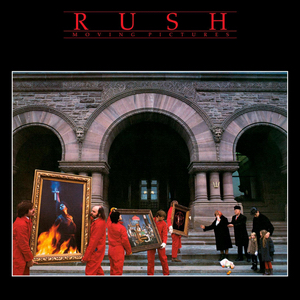MOVING PICTURES
RUSH
1981
Anthem/Mercury
Prod. by Rush &
Terry Brown
It’s obviously worth
noting that I come into these Rush reviews with a slightly predetermined
mindset. In any review of the band Rush’s music, I will do my best to displace
my previous distaste for the band, but I will repeatedly make it clear that, in
the past, Rush has most certainly not been
my thing, and I am here to
challenge that idea and try to enjoy a band millions around the world revere.
Rush’s Moving Pictures is probably their most accessible record.
With multiple classic rock staples, its place is cemented throughout the annals
of rock history. However, I find it hard to recommend Moving Pictures, which is
ultimately a collection of songs rather than a concept album, to anyone who has
heard these songs extensively through classic rock radio.
Yes, “Tom Sawyer” is a brilliant piece of music on a fresh
listen; who could deny that? Its trance-like synth and guitar is just about perfect, and it's one of the most unified songs the band's ever had. It's one of few times a song was clearly written around a series of drum lines Neil Peart had created, and it's wildly successful, though it's worth noting how much of a team player bass player Geddy Lee manages to be here as well. The vocals on the track are still as mediocre or
frustrating as most Rush songs (your mileage will always vary in regards to the caterwauling of Geddy Lee) but they don't really detract from the quality. To those who
would deny the awesomeness of the famous drum fills on the studio version of the song,
I salute you for entering a realm of Rush denialism that eclipses my own.
But parts of “Tom Sawyer”, “YYZ”, and “Limelight” fail to
impress after years of exposure. They’re high-energy, they’re well-crafted, and they certainly stand out more successfully than some of Rush’s
other songs. But the big punches in "Tom Sawyer" and "YYZ" are moments of intense technical skill rather
than beauty or humanity, and so the “songs” serve as vehicles for moments of a
good show. Meanwhile, "Limelight" has always seemed like a song that belonged to another band, and on multiple listens of the album, I simply lost focus during the song.
Alex Lifeson’s guitar contributions are rarely
exciting throughout Moving Pictures, and every Lee vocal bounces between
tolerable and distracting. This, of course, leaves Rush with their most famous
attributes; Lee’s bass-playing and Neil Peart’s drumming, both regarded
as world-class players. Outside of “YYZ,” Lee does not receive center stage
often, and yet he continues to play as though he’s the only man on stage.
Basslines on “Limelight” and “The Camera Eye” force through unnecessarily,
leading to a handful of jumbled moments. These are quality basslines, but they’re often played at inopportune
times. Peart is much guiltier of this problem, playing ludicrous drum parts on “Red
Barchetta,” “Limelight,” and “Vital Signs” that distract far more than they
add. I’ll say once again that I believe Rush is an extremely talented trio of
players that have a tendency to compete with each other for the listener’s
focus rather than write a cohesive song.
As for the non-radio tracks, there’s enough to like that a
fan of the band’s style might adore Moving Pictures, but those that aren’t
crazy about Rush’s style won’t find much to love in the other songs. “Red
Barchetta” remains a casualty, as Lifeson’s best guitar riff is overshadowed by
Peart’s excessive drum lines. “The Camera Eye” is actually a very enjoyable
collection of different sections, but many of the riffs found in the 11 minutes
never really evolve into anything that earns the run-time. “Witch Hunt” and “Vital
Signs” are fine songs that simply fail to differentiate themselves from the
pack.
3/5
HIGHLIGHTS: “Tom
Sawyer,” “YYZ,” “Limelight”
MISSED OPPORTUNITIES:
“Red Barchetta,” “The Camera Eye”
NEXT STOP: Yes, “The
Yes Album”
AFTER THAT: Muse, “Black
Holes and Revelations”
Next stop in regards to Rush: Their 1975 album Fly By Night.

